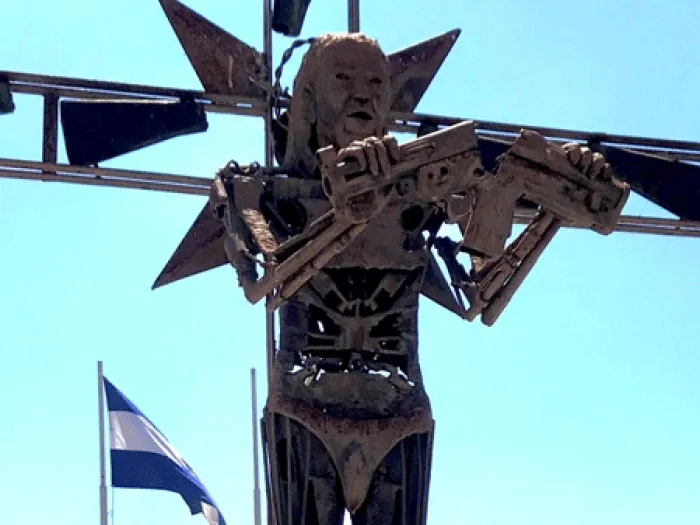Years of accompaniment by global partners and U.S. Presbyterians breathe new life into La Oroya, Peru
In a David versus Goliath story, La Oroya takes on the Peruvian government to establish adequate environmental measures


LOUISVILLE — La Oroya, Peru, is one of the most contaminated places on the planet, with decades of poison unleashed on this small community. For more than 20 years a group of citizens has advocated for the enforcement of adequate environmental measures.
Now, for the first time, there are signs of hope.
After four years of dialogue, this summer a federal law was passed to establish a comprehensive plan for specialized human and environmental health care for communities affected by toxic metal poisoning in Peru.
Yolanda Zurita has fought alongside her fellow citizens of La Oroya, asking for relief from the millions of pounds of toxins that were dumped on her city by a metallurgical smelter once owned by a U.S.-based holding company. She sat across from Prime Minister Mirtha Vásquez as the new law was negotiated. It was the first time ever a resident of La Oroya had been face-to-face with the highest authorities of government. Since June, the residents have worked with a multisector group representing 12 ministries of Peru’s government to design the plan.
PC(USA) global partner Red Uniendo Manos Peru, a global partner of the Presbyterian Mission Agency, joined with Zurita and others from La Oroya when the U.S.-based company failed to comply with measures to fix the problem. International outrage mounted and the company eventually lost its operating license, filed for bankruptcy and shut down operations in 2009.
But that was not the end of the story, nor the suffering.

The massive contamination over the course of years left nearly 1,000 square miles of land contaminated with lead, arsenic, cadmium and mercury. Various studies show extreme lead levels in the blood of a vast majority of the children in La Oroya, including newborn infants who were shown to have lead in their bodies at birth. Health facilities never developed the specialized care needed to address the cocktail of poisons affecting the bodies of those living in La Oroya and surrounding areas.
It became clear that further intervention from the state would be necessary to restore life, and thus a dream was born.
With the technical support and organizing capacity of Red Uniendo Manos Peru and the accompaniment of Presbyterians from the U.S., Zurita helped form the Regional Platform for Human and Environmental Health in Junin (La Oroya’s region). With community leaders from surrounding areas, they authored and advocated for a bill mandating that the regional government establish specialized health care, clean up environmental degradation and enforce more adequate environmental protections.
The bill was unanimously passed in 2012 by the regional government, but the work of designing and then implementing the plan had just begun. After five years of continuous negotiating with the regional government, a multi-sector and comprehensive plan was created.
“The effects of contamination or exposure to heavy metals cannot be treated in a sporadic, person- by-person or solely medical way,” said Zurita. “Effective response requires permanent care throughout the course of life, not only of the person but of the territories in which they live. For that, social, economic and environmental sustainability must be achieved.”
'From the margins, she can see so very clearly how interconnected the world is and how collaborative we must become to end the oppression.'
"It is difficult to guarantee good health as long as the sources of contamination remain in contact with the population," Zurita said. “Without the availability of safe water, without farmland, without the cleaning up of pollutants, without food security, without social policies, we cannot achieve good health and wellbeing.”
She emphasized that managing all those factors could not be done by the Ministry of Health alone. What was needed was a commitment by other ministries for a multisectoral plan. ¨
Ultimately, the regional government said it could not implement the plan without policy changes from the national government.

Undeterred, the group expanded to include other places in Peru affected by toxic metals from mining to strengthen their position with the national government. So, in 2017, with the support and guidance of the Red Uniendo Manos Peru, Zurita reached out to other communities and together they formed the National Platform of Communities Affected by Toxic Metals to negotiate with federal authorities.
It was a David versus Goliath story. Mining accounts for nearly two-thirds of export dollars in Peru, serving as the backbone of the economy. The industry has power and resources. Peru is considered one of the most mining friendly countries in the world and has among the highest potential for mining gold, copper, silver and other minerals. Yet nearly one-third the population is at risk for toxic metal poisoning.

The plan in question awaits final approval from the President of Peru, Pedro Castillo, and his cabinet, led by Vásquez, the prime minister.
“The many living at risk of toxic metals contamination should be inspired by the wisdom, intelligence, creativity, vision and perseverance of leaders like Yolanda,” said mission co-worker the Rev. Jed Koball. “She is showing us the way forward — the way to change oppressive systems, to change an apathetic society, to change our corrupt world. From the margins, she can see so very clearly how interconnected the world is and how collaborative we must become to end the oppression.”
You may freely reuse and distribute this article in its entirety for non-commercial purposes in any medium. Please include author attribution, photography credits, and a link to the original article. This work is licensed under a Creative Commons Attribution-NonCommercial-NoDeratives 4.0 International License.

